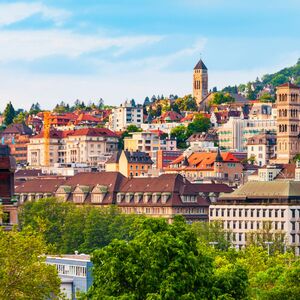Challenge: urban heat island
21.08.2023

What is an urban heat island?
An urban heat island refers to a space within an urban area where the temperature is significantly higher than in the surrounding rural areas, due to the accumulation of heat generated by human activities, the concentration of buildings, roads, asphalt surfaces, and little green space. This creates a hot microclimate that can impact on energy consumption, human health and the environment.
What are the main causes of urban heat island formation?
What are Swiss cities doing to combat these urban heat islands?
Sources
LeNouvelliste - Article
MeteoSuisse - Article
CEA - Article
An urban heat island refers to a space within an urban area where the temperature is significantly higher than in the surrounding rural areas, due to the accumulation of heat generated by human activities, the concentration of buildings, roads, asphalt surfaces, and little green space. This creates a hot microclimate that can impact on energy consumption, human health and the environment.
What are the main causes of urban heat island formation?
- Urbanization and landscape modification: The construction of buildings, roads, parking lots and other impermeable surfaces replaces natural spaces such as meadows and forests, which have a natural cooling capacity. Materials such as concrete and asphalt absorb heat and release it slowly, contributing to rising temperatures.
- Lack of green spaces: Urban areas lacking green spaces such as parks, gardens and trees are less able to provide shade and evaporate water, thus limiting ambient air cooling.
- Human activities and heat sources: Urban activities such as traffic, industry and energy consumption generate waste heat. This heat accumulates in the air and surrounding structures.
- Reduced albedo effect: Dark surfaces absorb more solar energy than light ones. Urban areas with dark surfaces, such as asphalt, help absorb heat, raising local temperatures.
- Thermal insulation of buildings: Urban buildings store and retain heat, as they are often built with materials that have a low capacity to regulate temperature.
- Local weather effects: Local weather conditions, such as lack of wind in dense urban areas, can also contribute to the formation of heat islands by preventing the dispersion of accumulated heat.
What are Swiss cities doing to combat these urban heat islands?
- Sion: the city has changed its philosophy in terms of public planning, which now aims to bring more greenery and water features to the heart of the city. A program that began ten years ago and is beginning to bear fruit.
- Canton of Vaud: the overall objective is to increase the area covered by tree leaves by 10% by 2040 (from the current 20% to 30% in the future). In addition, the canton plans to install a misting fountain and brighter floor coverings in certain particularly hard-hit locations.
- Canton of Geneva: over the past few years, "micro-oases" have been installed to create shaded areas with misting fountains in which to sit.
- Delémont: the town plans to remove concrete surfaces and replace them with permeable ones. It also plans to plant around 30 trees in the old town.
- Neuchâtel: here, in 2023, around 400 square metres of asphalt have been removed to make way for gravel and grass. In addition, the city has pruned parasol-shaped trees to provide shade.
- Lucerne: the city decided to opt for light-colored asphalt to combat heat islands.
- Basel: the city is announcing the installation of potted trees, misting systems and sails over shopping streets.
- Berne: the city is testing several tree species to determine which types are best able to withstand hot summers and prolonged drought. The trial is expected to last 10 years. In addition, the capital has just replaced 1,000 square meters of asphalt with a more durable material and new trees.
Sources
LeNouvelliste - Article
MeteoSuisse - Article
CEA - Article


